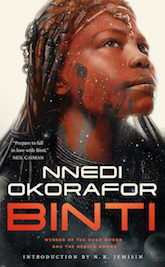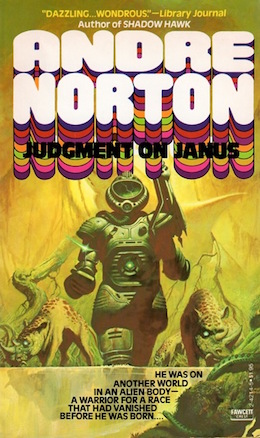I had an odd reaction to this entry in the Norton canon. It starts off with a fridging—killing off the protagonist’s mom to get the plot in gear—and then, to make things just plain weird, he turns into the Green Goblin. But then I started to kind of like Naill Renfro, and when Ashla showed up, I realized I was enjoying the ride. By the time I got to the end, I was eager to move on to the sequel (and next time I will).
The broad outlines of the plot are very familiar by now. War refugee living in the slums of pleasure world loses maternal figure and ships out to frontier planet that turns out to be full of ancient alien artifacts. There’s a lot here that reminds me of the Forerunner series, particularly the Simsa books, but Judgment was published much earlier, in 1963. This means male protagonist and heavily male-dominated culture, but there are definite cracks in the facade. I don’t think it’s a coincidence that the Witch World books began to appear at just about this time. Norton was moving on past boys’ adventure to something much more, dare I say, it feminist.
In this particular iteration, baby Free Trader Naill Renfro’s ship was caught in the perpetual war that torments this universe, his father killed, and he and his mother dumped as refugees in the Dipple (where the displaced people go) in Korwar. His mother is dying. He wants to give her a merciful death, which means expensive drugs, and the only way to get them is to sell himself.
This being Norton, that doesn’t mean what it might mean in another story. He signs on as a slave laborer, and ends up on Janus, a forest world which has been colonized by a fanatical religious sect. The sect is all about sin and repression, and about eradicating the forest. The forest fights back by infecting some of the colonists with the “Green Sick.” There are also, Naill learns in short order, treasure troves of alien artifacts which turn up around the settlements, and which are destroyed with great ceremony and ferocious thoroughness.
As soon as Naill learns about this, he finds a trove, and is irresistibly drawn to the items in it, especially a kind of shiny tube. He tries to hide it when the treasure is destroyed, but is caught. And then he becomes sick.
The artifacts are the cause of the infection. And, Naill discovers when he comes to, the disease transforms its victims into aliens with alien memories. He is now a hairless green goblin with huge pointed ears and eyes that can’t tolerate sunlight, and he has the memories of an ancient alien warrior named Ayyar. He also discovers that he physically cannot tolerate humans. Even the sight of them causes visceral revulsion. This feeling is mutual: humans run screaming from the green monster.
Drawn by his fragmentary alien memories and driven by human hunters with hounds, Naill makes his way to the now ruined tree-city from which his alien alter ego came, where he discovers recent evidence of others like him. But they’re gone, and he sets out to find them, acquiring a sentient alien bird companion along the way. He just misses catching up with them as they set sail on the sea, and backtracks to the city.
In the process he passes by a human garth, and spies on a young woman named Ashla, who like him stumbles on an alien trove and fixates on one of its artifacts—in her case, a green necklace. Ashla becomes ill and is transformed as Naill was; Naill helps her escape pursuit and guides her back to the city. Along the way he learns that she carries the memory of a kind of sorceress named Illylle, and helps her deal with the transition from human to alien.
Ashla/Illylle is a dominant female, with much more and deeper knowledge than Naill/Ayyar. She turns out to be a key to the mystery of Janus, especially once they’re captured by an eerie animated spacesuit and imprisoned in a crystal maze.
The suit and the maze are controlled by the ancient enemy of the green people, referred to most often as It (but it’s neither a clown nor a power of Kamazotz). This creature or force manifests as hard daylight and burning sun, versus the nocturnal good guys, and its powers are contained in lifeless rock rather than living things. The good guys have been fighting it for millennia, and lost the last war, to the point of extermination.
But they have managed somehow (the details remain a mystery in this volume) to manufacture the treasures and plant them where humans will find them. In this way they create “changelings” who carry fragmented alien memories and are deliberately designed to be repelled by their original species. The intention is to repopulate the planet and restore their civilization.
All of this becomes much clearer when Naill and Ashla find a group of fellow captives who have also been transformed, and who have been on this planet for a very long time. One of them in fact is the First-In Scout who discovered the planet. So it seems they’re immortal, more or less. They sort out who they all are and band together to break out of prison and defeat the enemy—the latter aided by Naill’s avian ally and a flock of its fellows.
Buy the Book


Binti
And so It is beaten (though not permanently) and our band of heroes heads back to the ancient city, which they plan to rebuild. Considering that the next volume is titled Victory on Janus, I can guess how that will turn out.
Norton has a great deal to say here. She speaks firmly and unequivocally against religious intolerance and for freedom of thought and belief. She depicts aliens who look dramatically different from humans but whose emotions and motivations are ultimately very human. And her token female major character is not only dominant, she helps unravel the mystery of the planet. Ashla comes from a horribly repressive society, but it’s clear she had a mind of her own even before she transformed into Illylle. She easily takes the lead in the adventure, and has no problem telling the men what to do. Nor do the men contest her right to do so.
In that she’s the spiritual sister of Maelen and Jaelithe and the rest of Norton’s powerful women. Actual human women are still nearly invisible, but this is a start. Later in her career, of course, Norton edged away from the all-male human universe to one with more gender parity.
She’s pretty hardline about various forms of human governance, too. Her universe here is relentlessly capitalist, controlled by guilds and cartels, corporations and companies. It’s all about profit. But it’s also about colonialism, and about the rights of native peoples.
As we’ve seen in other novels set in this universe, if a planet is inhabited by intelligent beings, that planet is off limits to colonization. If and when Naill and company succeed in rebuilding the culture of Janus, the horrible religious fanatics will have to leave, and by law Janus will belong to its native inhabitants—though the way in which they’ve been recreated might add complications. I’m looking forward to the next volume, and to seeing how the changelings and their children (who do not inherit ancient memories) manage to reclaim Janus.
Judith Tarr’s first novel, The Isle of Glass, appeared in 1985. Her short novel, Dragons in the Earth, a contemporary fantasy set in Arizona, was published recently by Book View Cafe. In between, she’s written historicals and historical fantasies and epic fantasies and space operas, some of which have been published as ebooks from Book View Café. She has won the Crawford Award, and been a finalist for the World Fantasy Award and the Locus Award. She lives in Arizona with an assortment of cats, a blue-eyed dog, and a herd of Lipizzan horses.










